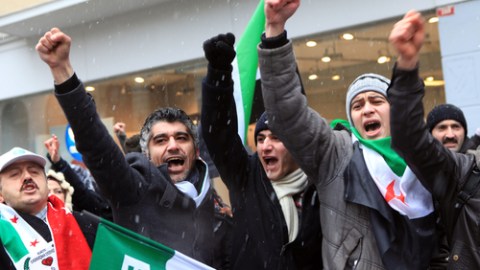The Arab Spring: The Third Phase of the Revolution

A number of analysts and scholars of the Middle East have argued that the revolutions and uprisings taking place in Libya, Egypt, Tunisia, Yemen and Syria are the first of their kind to take place in the region. However, a closer look at the history of the modern Middle East will reveal that these uprisings are not new to the region. In fact, the unrest is actually the third wave of revolutions to rock the modern Middle East.
The first waves of upheavals were the anti-colonial, nationalist revolutions of the 20th century, such as the Algerian Independence Movement against French colonial rule in the 1950s and 1960s. Widespread Algerian resistance movements led to Algerian independence in 1962. Algerians were not the only nation in the region fighting for their independence. Bahrain, a British protectorate since 1820, did not gain full sovereignty August 14, 1971. The Egyptian national resistance movement, led by Zaghlul Pasha and the Wafd Party, forced Great Britain to relinquish its hold over Egypt in 1922, when Egypt joined the community of sovereign nations. In the 1960s the Nationalist Liberation Front (NLF) in Yemen fought against British rule, which led to the establishment of the People’s Republic of Southern Yemen in November of 1967. The Iranian revolution led to the establishment of the Islamic republic of Iran in 1979. Although a multitude of different parties participated in the revolution, the Islamic Republic of Iran was formed by a majority vote.
What the world is currently witnessing in the Middle East is the third wave of revolutions in the region. This wave of uprisings emphasizes civil liberties, individualism, rule of law, democracy, and a more liberal interpretation of religion and economics. Economically speaking, while a small portion of the middle class has been able to accumulate capital, others have experienced a decrease in their quality of life as they have joined the ranks of the wage-earning classes who make up the majority of the population. Today a civil service employee or school teacher must work two or three jobs just to meet the basic needs of his or her family, which is likely to include some unemployed members. For example, he might teach by day and drive a taxi by night.
Resistance in Syria centers on the struggle against hunger, poverty, corruption and unemployment rather than general civil disobedience. According to UN figures, approximately 25 percent of the Syrian people live below the poverty line. According to opposition economist Aref Dalila, 50 percent live below the poverty line. When the Baath Socialist Party rose to power, modes of production remained the same as they were under the rule of the previous party. Under the rule of Bashar al-Assad, capital is accumulated in a few new sectors that are controlled by the bureaucratic bourgeoisie while the dominant modes of production remained intact. These policies fractured the middle class which led to a vast increase in the disparity between the rich and poor.
In December of 2010 mainly educated, middle class Tunisians initiated the third wave of revolutions currently raging in the Middle East and North Africa. Prior to the Tunisian revolution, the unemployment rate for college graduates was as high as 20 percent. The revolutions were sparked by the powerful act of self-immolation by a college graduate named Mohamed Bouazizi who was forced to peddle vegetables for a living until his license was revoked by the government. A common thread that links the revolutions taking place in Libya, Tunisia, Egypt, is the soul-crushing high rate of youth unemployment. Twenty-four percent of young people in the region cannot find jobs. Full of zeal and relatively free of responsibilities, the youth are traditionally the demographic that is most likely to challenge the status quo and question authority, which is clearly the case in Tunisia, Egypt and other nations in the Middle East.
In addition to economic concerns, this third phase of revolutions emphasizes freedom of press, the protection of civil liberties, and the combining of both civil rights and religion. The objective, for many of the newest revolutionaries, is to find a way to merge rights and religiosity, freedom and faith, liberty and religion. Rather than over-emphasizing mandatory duties, these uprisings emphasize rights, rule of law, and pluralism as opposed to adherence to a singular authoritative voice. In addition, it aims to marry Islam with modern values such as individuality and democratic freedoms. The new generation does not oppose secularism but rather, strives to achieve secularism by struggling for liberation from rigid, authoritarian, and theocratic. A wide range of different people including students, women, and state employees, are calling for individual rights, tolerance, and gender equality. The daily resistance and struggles of ordinary people, that sparked the on-going demonstrations, has compelled political actors to initiate crucial paradigm shifts.
In addition to being representative, inclusive, transparent, and respectful of human dignity and gender equality, future governments of the Middle East must make job creation a top priority. Whatever new regimes take power, new models for anything ranging from finance to education to scientific research must be reinvented. The new regimes must find ways of engaging today’s youth, nurture their drive, passion and expertise, rather than increasing tuition fees and cut back on retraining . If these serious issues are not addressed, there is no doubt that the youth will organize a collective response against their governments, as they are doing today. New governments must assist youth by helping them take advantage of the web-based tools at their disposal rather than wait for the same web-based tools to be used against them.
Majid Rafizadeh, an Iranian-Syrian, is scholar, policy analyst and human rights activist. As a scholar, he came to the United States on a Fulbright teaching scholarship where he taught at University of California, Santa Barbara. He is also contributing editor for Harvard International Review and ambassador to the National Iranian American Council. Formerly, he conducted research at Woodrow Wilson International Center for Scholars and participated at the National Council on US-Arab relations.




